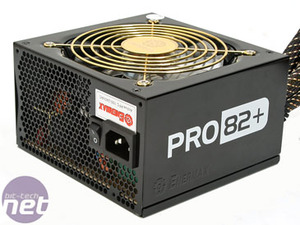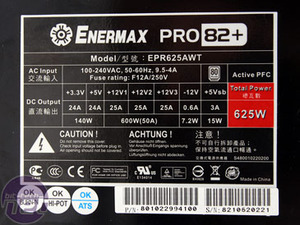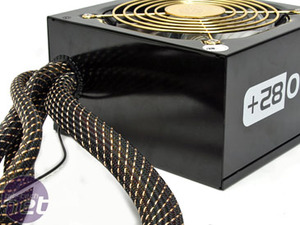Pro Looks
Enermax adorns the 82+ range in its same gloss black finish it applies to its Galaxy PSUs, but we feel it doesn’t look quite as good as the brushed metal look on the Infiniti. There are large “Pro 82+” logos on either side, in addition to embossed Enermax logo underneath – while large and in your face, it still looks good because the of the finish is a quality one. It’s also one that surprisingly isn’t a magnet for fingerprints either.The large 12cm clear fan is branded and manufactured by Enermax and although it’s clear bladed, it doesn’t light up. The fan is a two ball bearing design for longer life; however it’s very much not a smooth starter as it needs quite a flick to get going. As the cooling fan is one of the key elements to the MTBF rating, a quality fan is essential to the reliability of the unit.
As Enermax builds its own fans now we can’t yet comment on the reliability but it should have better quality control as it oversees the entire process. With that said though, it doesn’t yet have a proven reliability equivalent to that of Sayno Denki, Panasonic (Panaflo), ADDA, YSTech or any number of industrial companies.
Enermax’s fan is unusual in that it uses four cables instead of the usual two – this includes speed monitoring and PWM control and it is all bundled into a patented feature called SpeedGuard. According to Enermax, this uses “advanced fuzzy logic speed control to provide optimal cooling and minimum noise.”
The gold fan grill is also Enermax branded and the screws are even countersunk into the lid. However, the grill still sits a few millimetres above the unit which could mean it catches if you’re sliding it into tight spots in some cases.
Enermax designs and makes its own PSUs – a benefit the company has rode for many years. By controlling the whole process it’s theoretically easier to keep the quality high, costs down and try new R&D innovations. However, this isn’t always necessarily true: while Enermax has a very strong brand for the most part, its PSUs are often more expensive and the quality of a few ranges in recent years have been less than stellar.
The back of the unit has a hexagonal grill with the same size holes of many other PSUs we’ve previously seen (they need to be a certain size to stop objects entering and also work to contain specific EMI emissions), but this time around they are the only air exhaust. The inside cover (where the cables sprout from) or either side has no exhaust either, so we wonder how the air that cools the components at opposite end to the exhaust can efficiently escape.

MSI MPG Velox 100R Chassis Review
October 14 2021 | 15:04













Want to comment? Please log in.